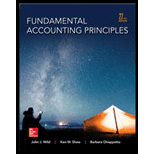
1.
Introduction:
Cash Flow: This can be defined as cost and benefits of a project. The
To calculate: -
The amount of annual
2. (a)
Introduction: -
Capital Assets: - it can be calculated by considering the investments made in assets which are made for longer period of time.
To calculate: -
Amount invested in capital assets?
2. (b)
Introduction: -
Cash Flow: - This can be defined as cost and benefits of a project. The cash outflows term is used for cost and cash inflows term is used for benefits of the project. Sometimes the term present value of cash flow is used to define the discounted value of the current period of a future sum of money.
Internal Rate of Return (IRR):- It is defined as a metric applied in order to measure the profitability of potential investment. It is a discount rate which makes net present value of all cash flow equals to zero.
To calculate: -
Amount of annual cash flows to have a 10% internal rate of return?
Want to see the full answer?
Check out a sample textbook solution
Chapter 25 Solutions
Fundamental Accounting Principles -Hardcover
- Emerge Tech reports that at an activity level of 6,200 machine-hours in a month, its total variable inspection cost is $372,320 and its total fixed inspection cost is $140,000. What would be the total variable inspection cost at an activity level of 6,500 machine-hours in a month? Assume that this level of activity is within the relevant range.arrow_forwardThe unit sales required to attain the company's monthly target profit of $45,000 isarrow_forwardI don't need ai answer general accounting questionarrow_forward
- I. Identify if the account title is an Asset, Liability, Equity, Income or Expense. Then, identify which side (Debit or Credit) will be used to record its increase and decrease. Example: Account Title Classification Increase Decrease Cash Asset Debit Credit Account Title Classification Increase Decrease Inventories Service Income Property, Plant and Equipment Insurance Expense Sales Accounts Payable Cost of Sales Withdrawals Notes Payable Unearned Revenues Salaries or Wages Expense Income Summary Accumulated Depreciation Cash Equivalents Mortgage Payable Supplies Expenses Bonds Payable Prepaid Expenses Notes Receivable Accrued Liabilities Capital Telecommunications, Electricity, Fuel and Water Expenses Depreciation Expense Uncollectible Accounts Expense Allowance for Uncollectible Accounts Rent Expense Interest Expense Intangible Assetsarrow_forwardAccounting answer pleasearrow_forwardPlease explain the solution to this Accounting problem with accurate principles.arrow_forward

 AccountingAccountingISBN:9781337272094Author:WARREN, Carl S., Reeve, James M., Duchac, Jonathan E.Publisher:Cengage Learning,
AccountingAccountingISBN:9781337272094Author:WARREN, Carl S., Reeve, James M., Duchac, Jonathan E.Publisher:Cengage Learning, Accounting Information SystemsAccountingISBN:9781337619202Author:Hall, James A.Publisher:Cengage Learning,
Accounting Information SystemsAccountingISBN:9781337619202Author:Hall, James A.Publisher:Cengage Learning, Horngren's Cost Accounting: A Managerial Emphasis...AccountingISBN:9780134475585Author:Srikant M. Datar, Madhav V. RajanPublisher:PEARSON
Horngren's Cost Accounting: A Managerial Emphasis...AccountingISBN:9780134475585Author:Srikant M. Datar, Madhav V. RajanPublisher:PEARSON Intermediate AccountingAccountingISBN:9781259722660Author:J. David Spiceland, Mark W. Nelson, Wayne M ThomasPublisher:McGraw-Hill Education
Intermediate AccountingAccountingISBN:9781259722660Author:J. David Spiceland, Mark W. Nelson, Wayne M ThomasPublisher:McGraw-Hill Education Financial and Managerial AccountingAccountingISBN:9781259726705Author:John J Wild, Ken W. Shaw, Barbara Chiappetta Fundamental Accounting PrinciplesPublisher:McGraw-Hill Education
Financial and Managerial AccountingAccountingISBN:9781259726705Author:John J Wild, Ken W. Shaw, Barbara Chiappetta Fundamental Accounting PrinciplesPublisher:McGraw-Hill Education





